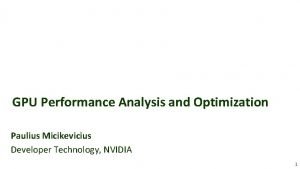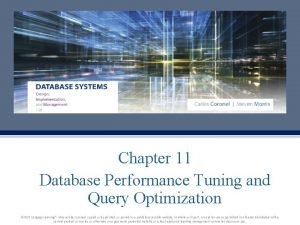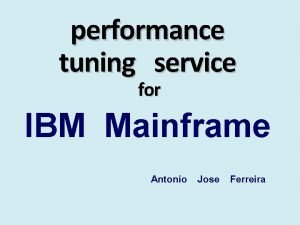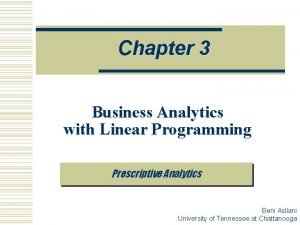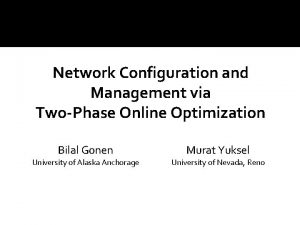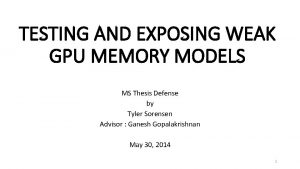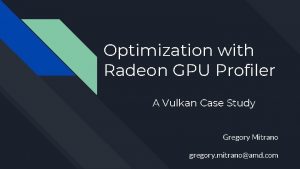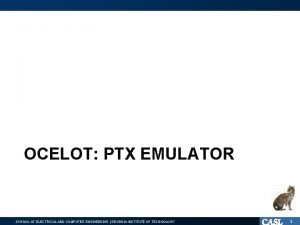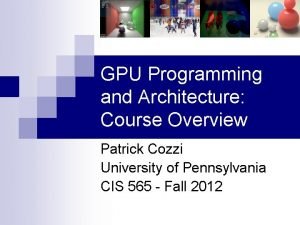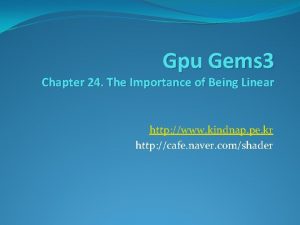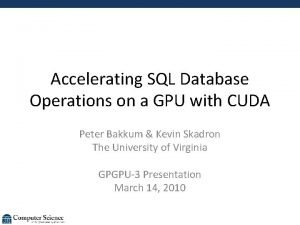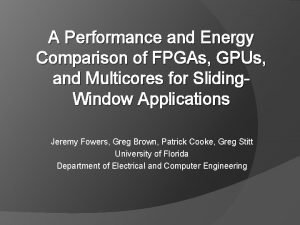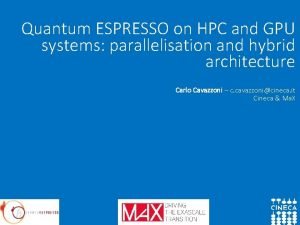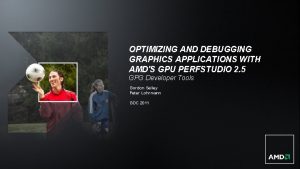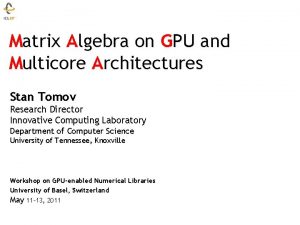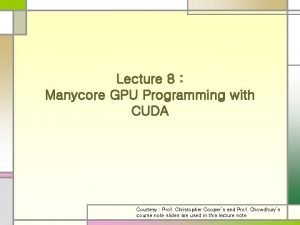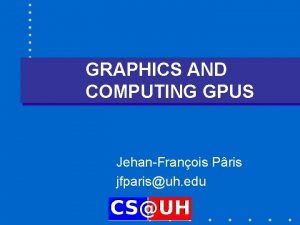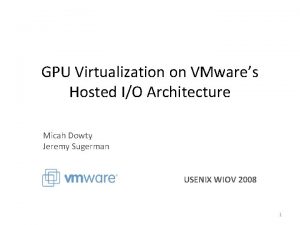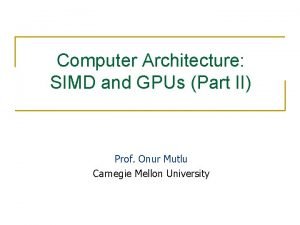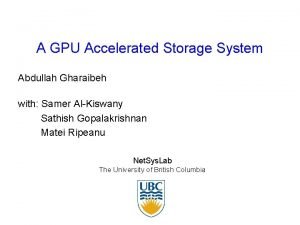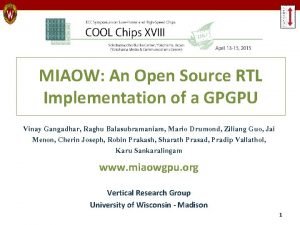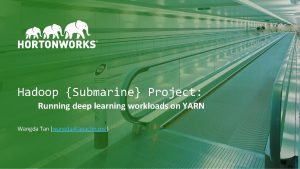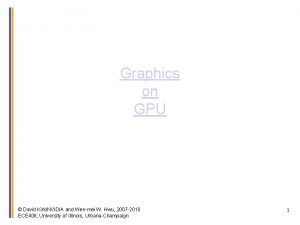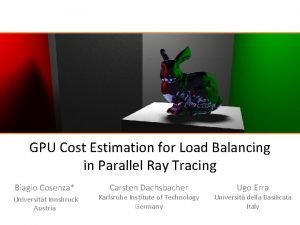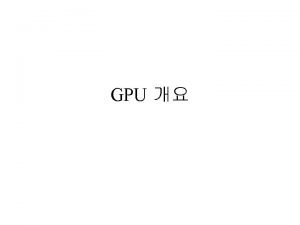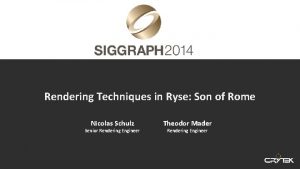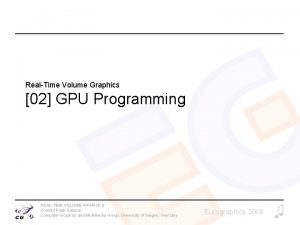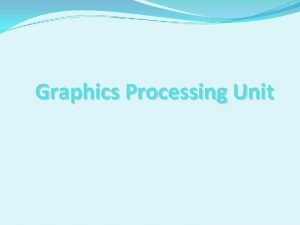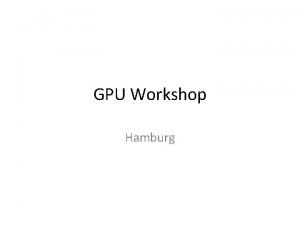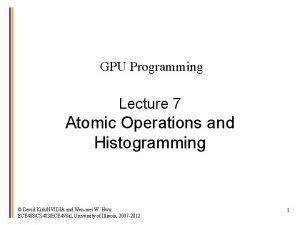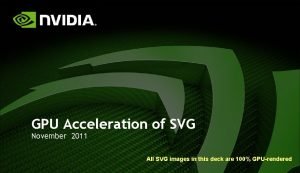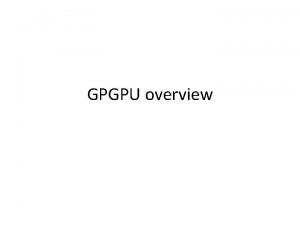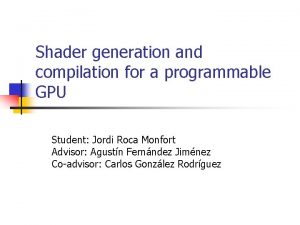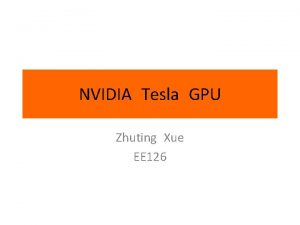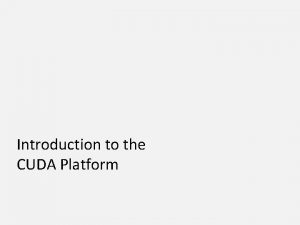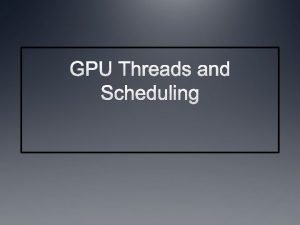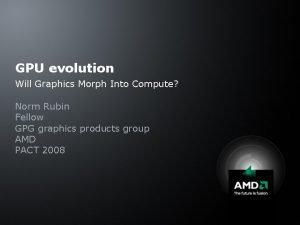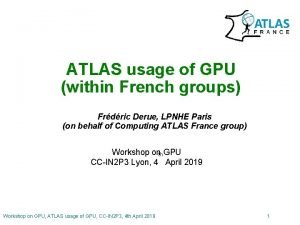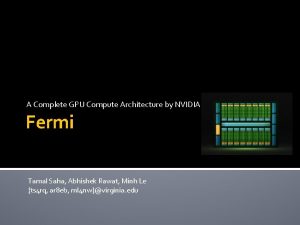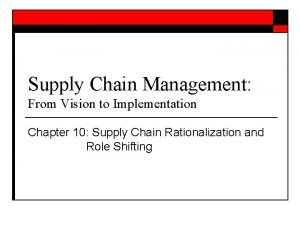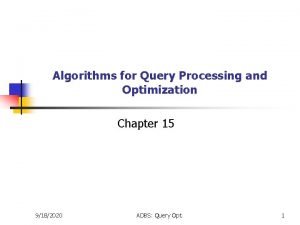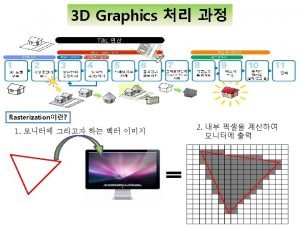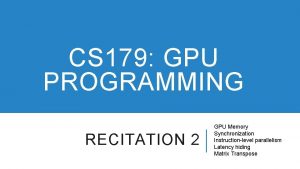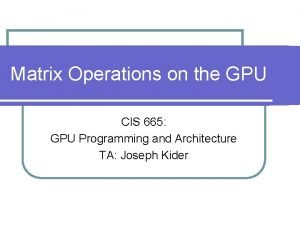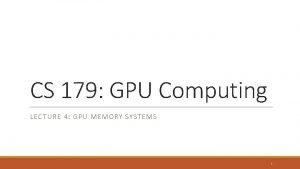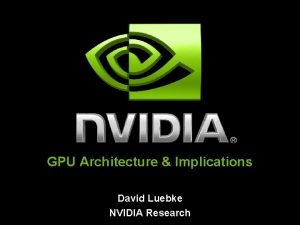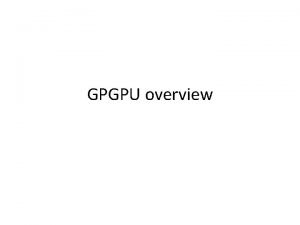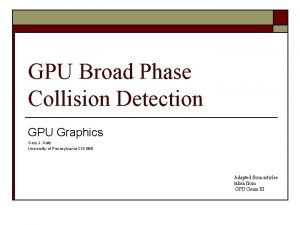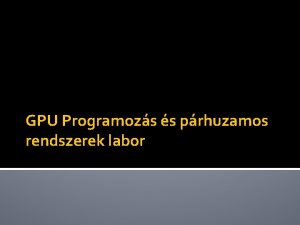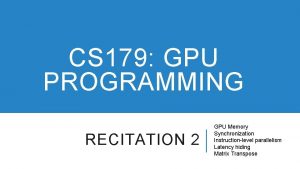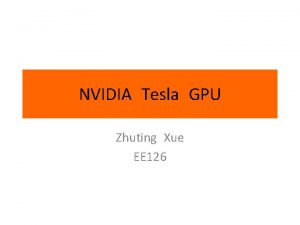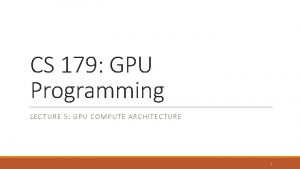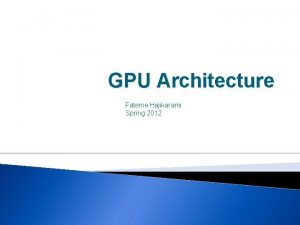GPU Performance Analysis and Optimization Paulius Micikevicius Developer

























![Structure of Non-Native Size • Compiler converts temp = data[idx] into 3 loads: – Structure of Non-Native Size • Compiler converts temp = data[idx] into 3 loads: –](https://slidetodoc.com/presentation_image_h/8325fd3abaee2c4ebc1859d91f6a3444/image-26.jpg)










































- Slides: 68

GPU Performance Analysis and Optimization Paulius Micikevicius Developer Technology, NVIDIA © 2012, NVIDIA 1

Main Requirements for GPU Performance • Expose sufficient parallelism • Use memory efficiently – Coalesce global memory access – Use shared memory where possible • Have coherent execution within warps © 2012, NVIDIA 2

EXPOSING SUFFICIENT PARALLELISM © 2012, NVIDIA 3

Parallelism Needed • GPU is a parallel machine – Lots of arithmetic pipelines – Multiple memory banks • To get good performance, your code must expose sufficient parallelism for 2 reasons: – To actually give work to all the pipelines – To hide latency of the pipelines • Rough rule of thumb for K 20 x: – You want to have 14 K or more threads running concurrently © 2012, NVIDIA 4

Exposing Sufficient Parallelism • What hardware ultimately needs: – Arithmetic pipes: • sufficient number of independent instructions – accommodates multi-issue and latency hiding – Memory system: • sufficient requests in flight to saturate bandwidth • Two ways to increase parallelism: – More independent work within a thread (warp) • ILP for math, independent accesses for memory – More concurrent threads (warps) © 2012, NVIDIA 5

Kepler: Level of Parallelism Needed • To saturate instruction bandwidth: – Fp 32 math: ~1. 7 K independent instructions per SM – Lower for other, lower-throughput instructions – Keep in mind that Kepler SM can track up to 2048 threads • To saturate memory bandwidth: – 100+ independent 128 -byte lines per SM © 2012, NVIDIA 6

Memory Parallelism • Achieved Kepler memory thoughput – As a function of the number of independent requests per SM – Request: 128 -byte line © 2012, NVIDIA 7

Occupancy • Occupancy: number of concurrent threads per SM – Expressed as either: • the number of threads (or warps), • percentage of maximum threads • Determined by several factors – (refer to Occupancy Calculator, CUDA Programming Guide for full details) – Registers per thread • SM registers are partitioned among the threads – Shared memory per threadblock • SM shared memory is partitioned among the blocks. Kepler SM resources – Threads per threadblock • Threads are allocated at threadblock granularity © 2012, NVIDIA – – 64 K 32 -bit registers Up to 48 KB of shared memory Up to 2048 concurrent threads Up to 16 concurrent threadblocks 8

Occupancy and Performance • Note that 100% occupancy isn’t needed to reach maximum performance – Once the “needed” occupancy is reached, further increases won’t improve performance • Needed occupancy depends on the code – More independent work per thread -> less occupancy is needed – Memory-bound codes tend to need more occupancy • Higher latency than for arithmetic, need more work to hide it © 2012, NVIDIA 9

Threadblock Size and Occupancy • Threadblock size is a multiple of warp size (32) – Even if you request fewer threads, HW rounds up • Threadblocks can be too small – Kepler SM can run up to 16 threadblocks concurrently – SM may reach the block limit before reaching good occupancy • Example: 1 -warp blocks -> 16 warps per Kepler SM (probably not enough) • Threadblocks can be too big – Quantization effect: • Enough SM resources for more threads, not enough for another large block • A threadblock isn’t started until resources are available for all of its threads © 2012, NVIDIA 10

Threadblock Sizing Too few threads per block Number of warps allowed by SM resources • SM resources: – Registers – Shared memory Too many threads per block © 2012, NVIDIA 11

General Guidelines • Threadblock size choice: – Start with 128 -256 threads per block • Adjust up/down by what best matches your function • Example: stencil codes prefer larger blocks to minimize halos – Multiple of warp size (32 threads) – If occupancy is critical to performance: • Check that block size isn’t precluding occupancy allowed by register and SMEM resources • Grid size: – 1, 000 or more threadblocks • 10 s of waves of threadblocks: no need to think about tail effect – See GTC 12 talk on optimization for more details on tails • Makes your code ready for several generations of future GPUs © 2012, NVIDIA 12

General Guidelines • Concurrent grids – Useful if any one given function doesn’t expose enough parallelism to saturate the GPU – Math pipes and memory system don’t really care where the work is coming from, as long as there’s enough of it • Two cases: – Concurrent grids from the same CPU process • Launch different functions into different streams – Several CPU processes sharing the GPU • Hyper. Q feature, available on Titan © 2012, NVIDIA 13

GLOBAL MEMORY ACCESS © 2012, NVIDIA 14

Kepler Memory Hierarchy L 1 SM-0 SM-1 SM-N Registers SMEM Read only L 1 SMEM Read only L 2 Global Memory (DRAM) © 2012, NVIDIA 15

Memory Hierarchy Review • Registers – Storage local to each threads – Compiler-managed • Shared memory / L 1 – – • 64 KB, program-configurable into shared: L 1 Program-managed Accessible by all threads in the same threadblock Low latency, high bandwidth: ~2. 5 TB/s Read-only cache – Up to 48 KB per Kepler SM – Hardware-managed (also used by texture units) – Used for read-only GMEM accesses (not coherent with writes) • L 2 – 1. 5 MB – Hardware-managed: all accesses to global memory go through L 2, including CPU and peer GPU • Global memory – 6 GB, accessible by all threads, host (CPU), other GPUs in the same system – Higher latency (400 -800 cycles) – 250 GB/s © 2012, NVIDIA 16

Blocking for L 1, Read-only, L 2 Caches • Short answer: DON’T • GPU caches are not intended for the same use as CPU caches – Smaller size (especially per thread), so not aimed at temporal reuse – Intended to smooth out some access patterns, help with spilled registers, etc. • Usually not worth trying to cache-block like you would on CPU – 100 s to 1, 000 s of run-time scheduled threads competing for the cache – If it is possible to block for L 1 then it’s possible block for SMEM • Same size • Same or higher bandwidth • Guaranteed locality: hw will not evict behind your back © 2012, NVIDIA 17

Memory Throughput Analysis • Two perspectives on the throughput: – Application’s point of view: • count only bytes requested by application – HW point of view: • count all bytes moved by hardware • The two views can be different: – Memory is accessed at 32 byte granularity • Scattered/offset pattern: application doesn’t use all the hw transaction bytes – Broadcast: the same small transaction serves many threads in a warp • Two aspects to inspect for performance impact: – Address pattern – Number of concurrent accesses in flight © 2012, NVIDIA 18

Global Memory Operation • Memory operations are executed per warp – 32 threads in a warp provide memory addresses – Hardware determines into which lines those addresses fall • Memory transaction granularity is 32 bytes • There are benefits to a warp accessing a contiguous aligned region of 128 or 256 bytes • Access word size – Natively supported sizes (per thread): 1, 2, 4, 8, 16 bytes • Assumes that each thread’s address is aligned on the word size boundary – If you are accessing a data type that’s of non-native size, compiler will generate several load or store instructions with native sizes © 2012, NVIDIA 19

• Scenario: – Warp requests 32 aligned, consecutive 4 -byte words • Addresses fall within 4 segments – Warp needs 128 bytes – 128 bytes move across the bus – Bus utilization: 100% addresses from a warp. . . 0 © 2012, NVIDIA 32 64 96 128 160 192 224 256 Memory addresses 288 320 352 384 416 448 20

• Scenario: – Warp requests 32 aligned, permuted 4 -byte words • Addresses fall within 4 segments – Warp needs 128 bytes – 128 bytes move across the bus – Bus utilization: 100% addresses from a warp. . . 0 © 2012, NVIDIA 32 64 96 128 160 192 224 256 Memory addresses 288 320 352 384 416 448 21

• Scenario: – Warp requests 32 misaligned, consecutive 4 -byte words • Addresses fall within at most 5 segments – Warp needs 128 bytes – At most 160 bytes move across the bus – Bus utilization: at least 80% • Some misaligned patterns will fall within 4 segments, so 100% utilization addresses from a warp. . . 0 © 2012, NVIDIA 32 64 96 128 160 192 224 256 Memory addresses 288 320 352 384 416 448 22

• Scenario: – All threads in a warp request the same 4 -byte word • Addresses fall within a single segment – Warp needs 4 bytes – 32 bytes move across the bus – Bus utilization: 12. 5% addresses from a warp. . . 0 © 2012, NVIDIA 32 64 96 128 160 192 224 256 Memory addresses 288 320 352 384 416 448 23

• Scenario: – Warp requests 32 scattered 4 -byte words • Addresses fall within N segments – Warp needs 128 bytes – N*32 bytes move across the bus – Bus utilization: 128 / (N*32) addresses from a warp. . . 0 © 2012, NVIDIA 32 64 96 128 160 192 224 256 Memory addresses 288 320 352 384 416 448 24

Structure of Non-Native Size • Say we are reading a 12 -byte structure per thread struct Position { float x, y, z; }; . . . __global__ void kernel( Position *data, . . . ) { int idx = block. Idx. x * block. Dim. x + thread. Idx. x; Position temp = data[idx]; . . . } © 2012, NVIDIA 25
![Structure of NonNative Size Compiler converts temp dataidx into 3 loads Structure of Non-Native Size • Compiler converts temp = data[idx] into 3 loads: –](https://slidetodoc.com/presentation_image_h/8325fd3abaee2c4ebc1859d91f6a3444/image-26.jpg)
Structure of Non-Native Size • Compiler converts temp = data[idx] into 3 loads: – Each loads 4 bytes – Can’t do an 8 and a 4 byte load: 12 bytes per element means that every other element wouldn’t align the 8 byte load on 8 -byte boundary • Addresses per warp for each of the loads: – Successive threads read 4 bytes at 12 -byte stride © 2012, NVIDIA 26

First Load Instruction addresses from a warp. . . 0 © 2012, NVIDIA 4 8 12 16 20 24 28 32 36 40 44 48 52 56 60 64 27

Second Load Instruction addresses from a warp. . . 0 © 2012, NVIDIA 4 8 12 16 20 24 28 32 36 40 44 48 52 56 60 64 28

Third Load Instruction addresses from a warp. . . 0 © 2012, NVIDIA 4 8 12 16 20 24 28 32 36 40 44 48 52 56 60 64 29

Performance and Solutions • Because of the address pattern, we end up moving 3 x more bytes than application requests – We waste a lot of bandwidth, leaving performance on the table • Potential solutions: – Change data layout from array of structures to structure of arrays • In this case: 3 separate arrays of floats • The most reliable approach (also ideal for both CPUs and GPUs) – Use loads via read-only cache • As long as lines survive in the cache, performance will be nearly optimal – Stage loads via shared memory © 2012, NVIDIA 30

Read-only Loads • Go through the read-only cache – Not coherent with writes – Thus, addresses must not be written by the same kernel • Two ways to enable: – Decorating pointer arguments as hints to compiler: • Pointer of interest: const __restrict__ • All other pointer arguments: __restrict__ – Conveys to compiler that no aliasing will occur – Using __ldg() intrinsic • Requires no pointer decoration © 2012, NVIDIA 31

Read-only Loads • Go through the read-only cache – Not coherent with writes – Thus, addresses must not be written by the same kernel • Two ways to enable: – Decorating pointer arguments toint*__restrict__ compiler: output, __global__ as voidhints kernel( • Pointer of interest: __restrict__ const { • All other pointer arguments: __restrict__ – const int* __restrict__ input ) – Conveys to compiler that. . . no aliasing will occur output[idx] =. . . + input[idx]; Using __ldg() intrinsic } • Requires no pointer decoration © 2012, NVIDIA 32

Read-only Loads • Go through the read-only cache – Not coherent with writes – Thus, addresses must not be written by the same kernel • Two ways to enable: – Decorating pointer arguments toint compiler: __global__ as voidhints kernel( *output, • Pointer of interest: __restrict__ const { • All other pointer arguments: __restrict__ – int *input ) – Conveys to compiler that. . . no aliasing will occur output[idx] =. . . + __ldg( &input[idx] ); Using __ldg() intrinsic } • Requires no pointer decoration © 2012, NVIDIA 33

Having Sufficient Concurrent Accesses • In order to saturate memory bandwidth, SM must issue enough independent memory requests © 2012, NVIDIA 34

Elements per Thread and Performance • Experiment: each warp has 2 concurrent requests (memcopy, one word per thread) – 4 B word request: 1 line – 8 B word request: 2 lines – 16 B word request: 4 lines • To achieve the same throughput at lower occupancy: – Need more independent requests per warp • To achieve the same throughput with smaller words: – Need more independent requests per warp 35 © 2012, NVIDIA

Optimizing Access Concurrency • Have enough concurrent accesses to saturate the bus – Little’s law: need (mem_latency)x(bandwidth) bytes • Ways to increase concurrent accesses: – Increase occupancy (run more warps concurrently) • Adjust threadblock dimensions – To maximize occupancy at given register and smem requirements • If occupancy is limited by registers per thread: – Reduce register count (-maxrregcount option, or __launch_bounds__) – Modify code to process several elements per thread • Doubling elements per thread doubles independent accesses per thread © 2012, NVIDIA 36

Optimizations When Addresses Are Coalesced • When looking for more performance and code: – Is memory bandwidth limited – Achieves high percentage of bandwidth theory – Addresses are coalesced • Consider compression – GPUs provide instructions for converting between fp 16, fp 32, and fp 64 representations: • A single instruction, implemented in hw (__float 2 half(), . . . ) – If data has few distinct values, consider lookup tables • Store indices into the table • Small enough tables will likely survive in caches if used often enough © 2012, NVIDIA 37

L 1 Sizing • Shared memory and L 1 use the same 64 KB – Program-configurable split: • Fermi: 48: 16, 16: 48 • Kepler: 48: 16, 16: 48, 32: 32 – CUDA API: cuda. Device. Set. Cache. Config(), cuda. Func. Set. Cache. Config() • Large L 1 can improve performance when: – Spilling registers (more lines in the cache -> fewer evictions) • Large SMEM can improve performance when: – Occupancy is limited by SMEM © 2012, NVIDIA 38

Summary: GMEM Optimization • Strive for perfect address coalescing per warp – Align starting address (may require padding) – A warp will ideally access within a contiguous region – Avoid scattered address patterns or patterns with large strides between threads • Analyze and optimize address patterns: – – Use profiling tools (included with CUDA toolkit download) Compare the transactions per request to the ideal ratio Choose appropriate data layout (prefer So. A) If needed, try read-only loads, staging accesses via SMEM • Have enough concurrent accesses to saturate the bus – Launch enough threads to maximize throughput • Latency is hidden by switching threads (warps) – If needed, process several elements per thread • More concurrent loads/stores © 2012, NVIDIA 39

SHARED MEMORY © 2012, NVIDIA 40

Shared Memory • On-chip (on each SM) memory • Comparing SMEM to GMEM: – Order of magnitude (20 -30 x) lower latency – Order of magnitude (~10 x) higher bandwidth – Accessed at bank-width granularity • Kepler: 8 bytes • For comparison: GMEM access granularity is either 32 or 128 bytes • SMEM instruction operation: – 32 threads in a warp provide addresses – Determine into which 8 -byte words addresses fall – Fetch the words, distribute the requested bytes among the threads • Multi-cast capable • Bank conflicts cause serialization © 2012, NVIDIA 41

Kepler Shared Memory Banking • 32 banks, 8 bytes wide – Bandwidth: 8 bytes per bank per clock per SM (256 bytes per clk per SM) – 2 x the bandwidth compared to Fermi • Two modes: – 4 -byte access (default): • Maintains Fermi bank-conflict behavior exactly • Provides 8 -byte bandwidth for certain access patterns – 8 -byte access: • Some access patterns with Fermi-specific padding may incur bank conflicts • Provides 8 -byte bandwidth for all patterns (assuming 8 -byte words) – Selected with cuda. Device. Set. Shared. Mem. Config() function arguments: • cuda. Shared. Mem. Bank. Size. Four. Byte • cuda. Shared. Mem. Bank. Size. Eight. Byte © 2012, NVIDIA 42

Kepler 8 -byte Bank Mode • Mapping addresses to banks: – Successive 8 -byte words go to successive banks – Bank index: • (8 B word index) mod 32 • (4 B word index) mod (32*2) • (byte address) mod (32*8) – Given the 8 least-significant address bits: . . . BBBBBxxx • xxx selects the byte within an 8 -byte word • BBBBB selects the bank • Higher bits select a “column” within a bank © 2012, NVIDIA 43

Kepler 8 -byte Bank Mode • To visualize, let’s pretend we have 4 banks, not 32 (easier to draw) Byte-address: 0 4 8 12 16 20 24 28 32 40 38 9 0 1 2 3 4 5 6 7 8 Data: (or 4 B-word index) 0 8 1 9 Bank-0 © 2012, NVIDIA 2 3 Bank-1 4 5 Bank-2 6 7 Bank-3 44

Shared Memory Bank Conflicts • A bank conflict occurs when: – 2 or more threads in a warp access different words in the same bank • Think: 2 or more threads access different “rows” in the same bank – N-way bank conflict: N threads in a warp conflict • Instruction gets issued N times: increases latency • Note there is no bank conflict if: – Several threads access the same word – Several threads access different bytes of the same word © 2012, NVIDIA 45

SMEM Access Examples Addresses from a warp: no bank conflicts One address access per bank Bank-0 © 2012, NVIDIA Bank-1 Bank-2 Bank-31 46

SMEM Access Examples Addresses from a warp: no bank conflicts One address access per bank Bank-0 © 2012, NVIDIA Bank-1 Bank-2 Bank-31 47

SMEM Access Examples Addresses from a warp: no bank conflicts Multiple addresses per bank, but within the same word Bank-0 © 2012, NVIDIA Bank-1 Bank-2 Bank-31 48

SMEM Access Examples Addresses from a warp: 2 -way bank conflict 2 accesses per bank, fall in two different words Bank-0 © 2012, NVIDIA Bank-1 Bank-2 Bank-31 49

SMEM Access Examples Addresses from a warp: 3 -way bank conflict 4 accesses per bank, fall in 3 different words Bank-0 © 2012, NVIDIA Bank-1 Bank-2 Bank-31 50

Diagnosing Bank Conflicts • Profiler counters: – Number of instructions executed, does not include replays: • shared_load, shared_store – Number of replays (number of instruction issues due to bank conflicts) • l 1_shared_bank_conflict • Analysis: – Number of replays per instruction • l 1_shared_bank_conflict / (shared_load + shared_store) – Replays are potentially a concern because: • Replays add latency • Compete for issue cycles with other SMEM and GMEM operations – Except for read-only loads, which go to different hardware • Remedy: – Usually padding SMEM data structures resolves/reduces bank conflicts © 2012, NVIDIA 51

Summary: Shared Memory • Shared memory is a tremendous resource – Very high bandwidth (terabytes per second) – 20 -30 x lower latency than accessing GMEM – Data is programmer-managed, no evictions by hardware • Performance issues to look out for: – Bank conflicts add latency and reduce throughput – Many-way bank conflicts can be very expensive • Replay latency adds up • However, few code patterns have high conflicts, padding is a very simple and effective solution © 2012, NVIDIA 52

ARITHMETIC OPTIMIZATIONS © 2012, NVIDIA 53

Execution • Instructions are issued/executed per warp – Warp = 32 consecutive threads • Think of it as a “vector” of 32 threads • The same instruction is issued to the entire warp • Scheduling – Warps are scheduled at run-time – Hardware picks from warps that have an instruction ready to execute • Ready = all arguments are ready – Instruction latency is hidden by executing other warps 54

Conditional Control Flow • If at least one thread in a warp needs take a particular path: – All threads in a warp take that path – Threads that aren’t on that path: • Don’t fetch arguments, don’t write outputs: guarantees correctness • Still spend time, instead of executing their path: potential performance impact 55

instructions Control Flow © 2012, NVIDIA if (. . . ) { // then-clause } else { // else-clause } 56

Execution within warps is coherent 1 2 3 30 31 32 33 34 35 62 63 instructions / time 0 Warp (“vector” of threads) © 2012, NVIDIA Warp (“vector” of threads) 57

Execution diverges within a warp 1 2 3 30 31 32 33 34 35 62 63 instructions / time 0 © 2012, NVIDIA 58

Possible Performance Limiting Factors • Raw instruction throughput – Know the kernel instruction mix – fp 32, fp 64, int, mem, transcendentals, etc. have different throughputs • Refer to the CUDA Programming Guide / Best Practices Guide • Can examine assembly: use cuobjdump tool provided with CUDA toolkit – A lot of divergence can “waste” instructions • Instruction serialization – Occurs when threads in a warp issue the same instruction in sequence • As opposed to the entire warp issuing the instruction at once • Think of it as “replaying” the same instruction for different threads in a warp – Mostly: • Shared memory bank conflicts • Memory accesses that result in multiple transactions (scattered address patterns) 59

Instruction Throughput: Analysis • Compare achieved instruction throughput to HW capabilities – Profiler reports achieved throughput as IPC (instructions per clock) – Peak instruction throughput is documented in the Programming Guide • Profiler also provides peak fp 32 throughput for reference (doesn’t take your instruction mix into consideration) • Check for serialization – Number of replays due to serialization: instructions_issued - instructions_executed – Profiler reports: • % of serialization metric (ratio or replays to instructions issued) • Kepler: counts replays due to various memory access instructions – A concern if: code is instruction or latency-limited, replay percentage is high • Warp divergence – Profiler counters: divergent_branch, branch – Compare the two to see what percentage diverges • However, this only counts the branches, not the rest of serialized instructions 60

Instruction Throughput: Optimization • Use intrinsics where possible ( __sin(), __sincos(), __exp(), etc. ) – Available for a number of math. h functions – 2 -3 bits lower precision, much higher throughput • Refer to the CUDA Programming Guide for details – Often a single HW instruction, whereas a non-intrinsic is a SW sequence • Additional compiler flags that also help performance: – -ftz=true – -prec-div=false – -prec-sqrt=false : flush denormals to 0 : faster fp division instruction sequence (some precision loss) : faster fp sqrt instruction sequence (some precision loss) • Make sure you do fp 64 arithmetic only where you mean it: – fp 64 throughput is lower than fp 32 – fp literals without an “f” suffix ( 34. 7 ) are interpreted as fp 64 per C standard 61

Instruction Throughput: Summary • Analyze: – Check achieved instruction throughput – Compare to HW peak (but keep instruction mix in mind) – Check percentage of instructions due to serialization • Optimizations: – Intrinsics, compiler options for expensive operations – Group threads that are likely to follow same execution path (minimize warp divergence) – Minimize memory access replays (SMEM and GMEM) 62

In Conclusion • When programming and optimizing think about: – Exposing sufficient parallelism – Coalescing memory accesses – Having coherent control flow within warps • Use profiling tools when analyzing performance – Determine performance limiters first – Diagnose memory access patterns © 2012, NVIDIA 63

Additional Resources • Extended version of the optimization talk: – GTC 12 Session S 0514: GPU Performance Analysis and Optimization • Kepler architecture: – GTC 12 Session S 0642: Inside Kepler – Kepler whitepapers (http: //www. nvidia. com/object/nvidia-kepler. html) • Assessing performance limiters: – GTC 10 Session 2012: Analysis-driven Optimization (slides 5 -19): • http: //www. nvidia. com/content/GTC-2010/pdfs/2012_GTC 2010 v 2. pdf • Profiling tools: – GTC 12 sessions: • S 0419: Optimizing Application Performance with CUDA Performance Tools • S 0420: Nsight IDE for Linux and Mac • . . . – CUPTI documentation (describes all the profiler counters) • Included in every CUDA toolkit (/cuda/extras/cupti/doc/Cupti_Users_Guide. pdf • Register spilling: – Webinar: • Slides: http: //developer. download. nvidia. com/CUDA/training/register_spilling. pdf • Video: http: //developer. download. nvidia. com/CUDA/training/CUDA_Local. Memory. Optimization. mp 4 • GPU computing webinars in general: – http: //developer. nvidia. com/gpu-computing-webinars © 2012, NVIDIA 64

Questions © 2012, NVIDIA 65

Waves and Tails • Wave of threadblocks – A set of threadblocks that run concurrently on GPU – Maximum size of the wave is determined by: • How many threadblocks can fit on one SM – Number of threads per block – Resource consumption: registers per thread, SMEM per block • Number of SMs • Any grid launch will be made up of: – Some number of full waves – Possibly one tail: wave with fewer than possible blocks • Last wave by definition • Happens if the grid size is not divisible by wave size © 2012, NVIDIA 66

Tail Effect • Tail underutilizes GPU – Impacts performance if tail is a significant portion of time • Example: – GPU with 8 SMs – Code that can run 1 threadblock per SM at a time • Wave size = 8 blocks – Grid launch: 12 threadblocks time • 2 waves: – 1 full – Tail with 4 threadblocks SM • Tail utilizes 50% of GPU, compared to full-wave • Overall GPU utilization: 75% of possible wave 0 © 2012, NVIDIA wave 1 (tail) 67

Tail Effect: Few vs Many Waves of Blocks time SM 80% of time code runs at 100% of its ability, 20% of time it runs at 50% of ability: 90% of possible 95% of time code runs at 100% of its ability, 5% of time it runs at 50% of ability: 97. 5% of possible © 2012, NVIDIA 68
 Gpu performance analysis
Gpu performance analysis Paulius godvadas
Paulius godvadas Marcelijus martinaitis kai sirpsta vyšnios suvalkijoj
Marcelijus martinaitis kai sirpsta vyšnios suvalkijoj Database performance tuning and query optimization
Database performance tuning and query optimization Mainframe mips optimization
Mainframe mips optimization Linear optimization and prescriptive analysis
Linear optimization and prescriptive analysis Network configuration optimization analysis
Network configuration optimization analysis Gpu memory test
Gpu memory test Matlab parallel computing gpu
Matlab parallel computing gpu Rgp
Rgp Gpu ocelot
Gpu ocelot Grafikkarte funktion
Grafikkarte funktion Gpu architecture course
Gpu architecture course Gpu gems 3
Gpu gems 3 Gpu acceleration matlab
Gpu acceleration matlab Best gpu for scientific computing
Best gpu for scientific computing Gpu cache coherence
Gpu cache coherence Gpu sql database
Gpu sql database Fpga gpu comparison
Fpga gpu comparison Rendered insecure: gpu side channel attacks are practical
Rendered insecure: gpu side channel attacks are practical Operation per second
Operation per second Gpu perfstudio
Gpu perfstudio Gpu
Gpu Gpu
Gpu Gpu pris
Gpu pris Micah dowty
Micah dowty Simd vs gpu
Simd vs gpu Gpu accelerated storage
Gpu accelerated storage Conference in florida
Conference in florida Kvm gpu acceleration
Kvm gpu acceleration Adobe certified gpu
Adobe certified gpu Miaow gpu
Miaow gpu Hadoop deep learning
Hadoop deep learning Gpu
Gpu Gpu load balancing
Gpu load balancing Gpu
Gpu Svg basics
Svg basics Chrome helper gpu
Chrome helper gpu Flipque
Flipque Ryse son of rome map
Ryse son of rome map Gpu perfstudio
Gpu perfstudio Usemapevents
Usemapevents What is gpu
What is gpu Atlas gpu
Atlas gpu Gpu atomic operations
Gpu atomic operations Gpu svg
Gpu svg What is gpgpu
What is gpgpu Ff
Ff Tesla ee architecture
Tesla ee architecture Alea gpu
Alea gpu Amd gpu scheduling
Amd gpu scheduling Evolution
Evolution Gpu germany
Gpu germany Inkscape gpu acceleration
Inkscape gpu acceleration Gpu in french
Gpu in french Nvidia fermi gpu
Nvidia fermi gpu Behaviorally anchored rating scales
Behaviorally anchored rating scales Performance appraisal process
Performance appraisal process Jcids manual 2018
Jcids manual 2018 Chapter 9 flexible budget and performance analysis
Chapter 9 flexible budget and performance analysis Flexible budgets and performance analysis
Flexible budgets and performance analysis Flexible budget performance report example
Flexible budget performance report example Constrained and unconstrained optimization in economics
Constrained and unconstrained optimization in economics Relative vs absolute max and min
Relative vs absolute max and min Network design and optimization
Network design and optimization Supply base rationalization and optimization
Supply base rationalization and optimization Deep neural networks and mixed integer linear optimization
Deep neural networks and mixed integer linear optimization Supply chain management from vision to implementation
Supply chain management from vision to implementation Algorithms for query processing and optimization
Algorithms for query processing and optimization
